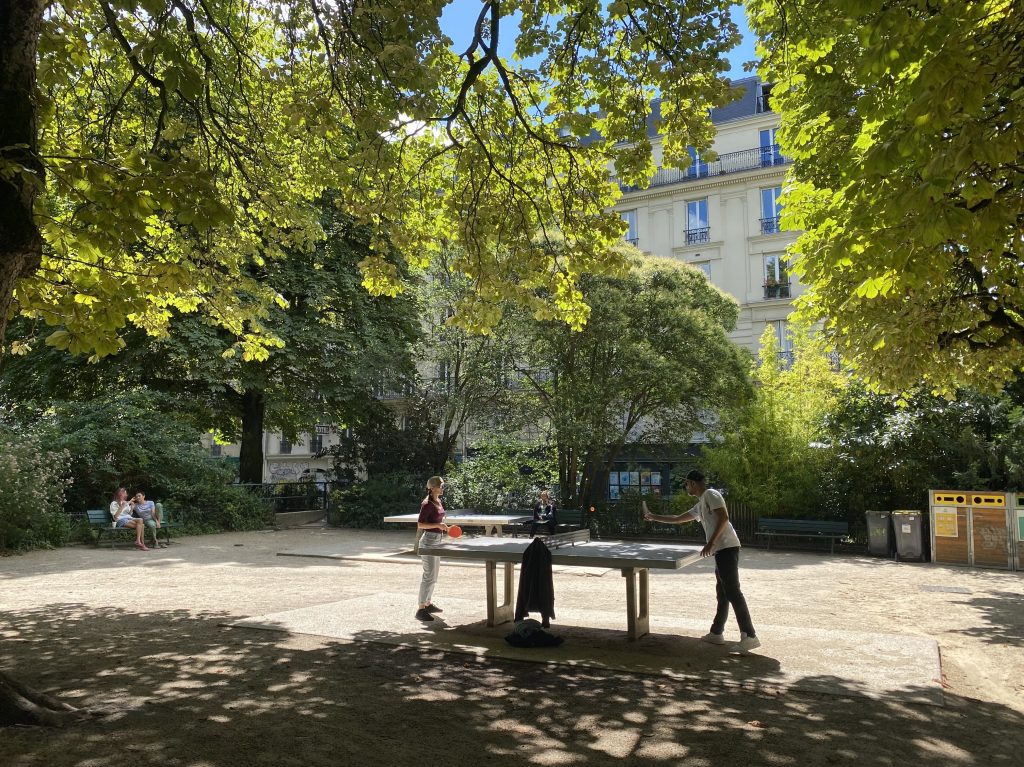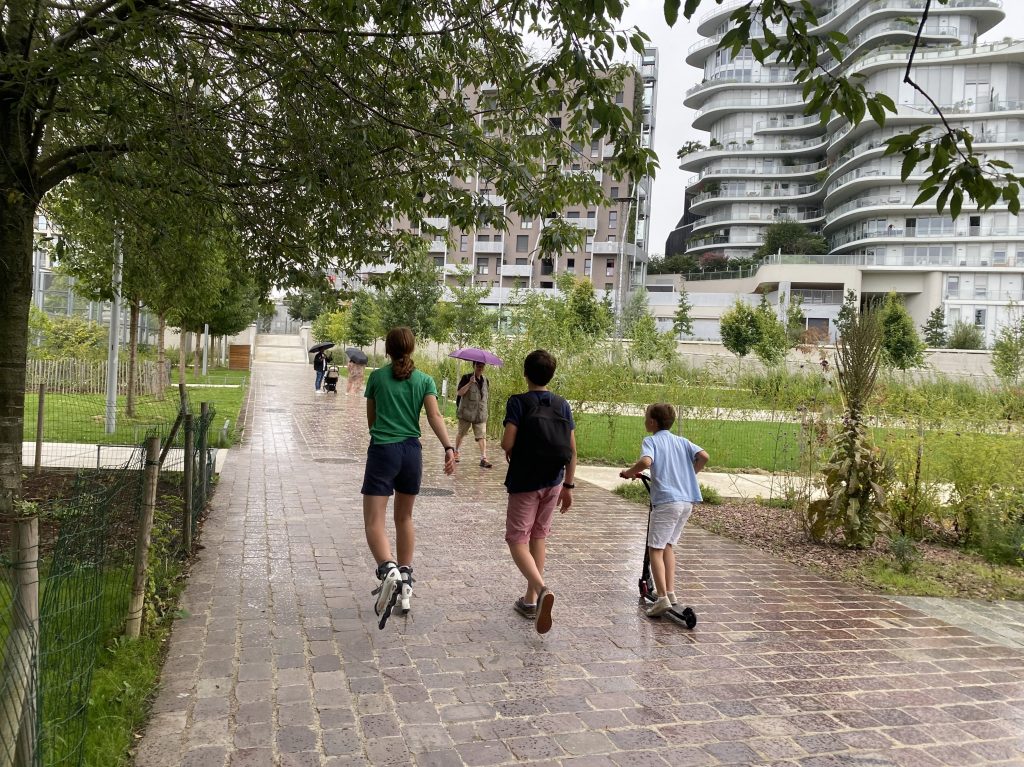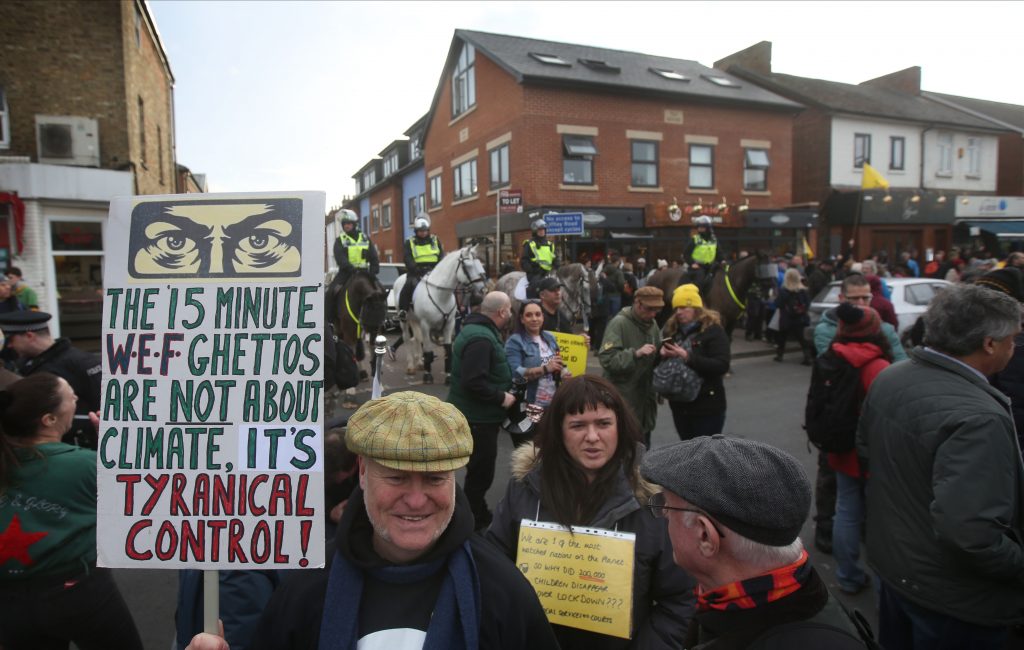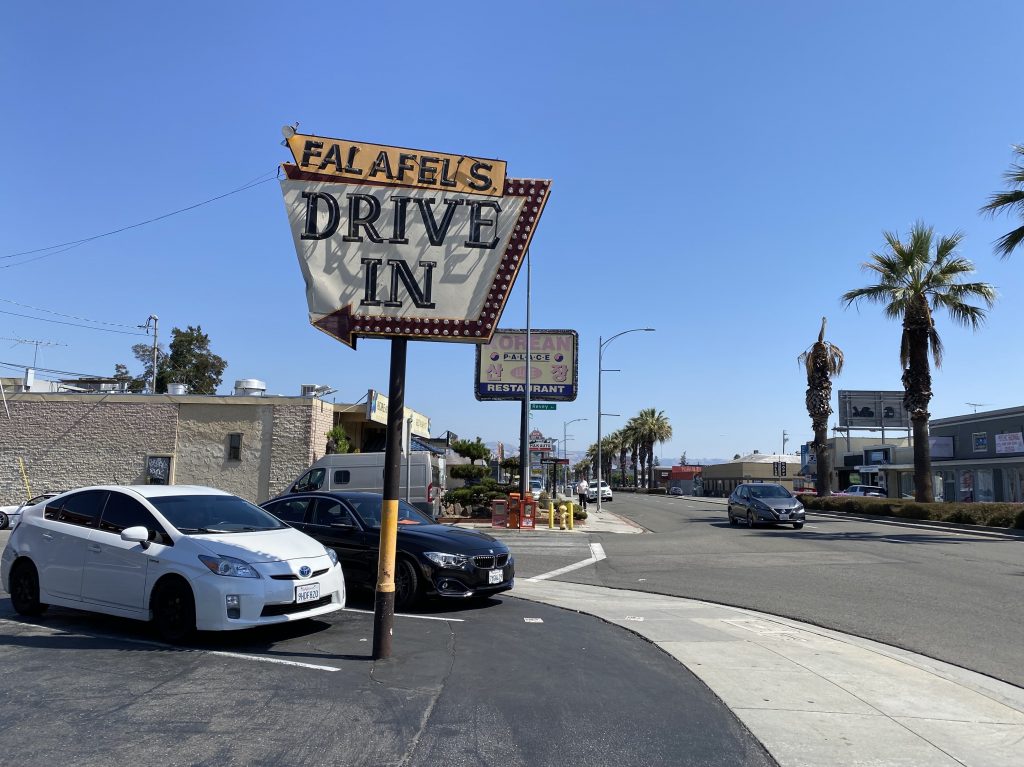News
It’s a global climate solution — if it can get past conspiracy theories and NIMBYs
By: Julia Simon | NPR
Posted on:
PARIS — In the 11th arrondissement, a middle-to-working class neighborhood in the east of Paris, if you walk out your front door, you can arrive at a preschool in one minute. A bookstore in three minutes. A cheese store in four minutes. Baguette for that cheese? Bakery’s across the street.
Grocery store and pharmacy, five minutes. Parks, restaurants, metro stops, a hospital: all within a 15-minute walk. I know this because I used to live there, on a tiny cobblestone street with buildings covered in vines.
This is a 15-minute city, says Carlos Moreno, a professor at University of Paris 1 Panthéon-Sorbonne, who met me on the banks of the Seine River. Moreno says that in a 15-minute city, a person can access key things in their life — work, food, schools and recreation — within a short walk, bike, or transit ride of their home.
My former Paris street and much of the neighborhood were built in this dense way more than 150 years ago. But this old idea of areas with many amenities close by has now evolved into an urban planning model gaining popularity with politicians around the world. Moreno says that’s because it not only improves quality of life, but 15-minute cities can also reduce cars’ planet-warming greenhouse gases. Transportation accounts for about 20% of global energy-related carbon dioxide pollution, with cars making up almost 10%, according to the International Energy Agency.
In recent years, Moreno has been helping mayors put this idea to use, particularly the mayor of Paris, Anne Hidalgo. Paris is converting old military buildings and old parking structures into mixed-use buildings with apartments, retail and office space. Parisian neighborhoods are opening new parks and community gardens and expanding hours for child care nurseries. And the city has built more than 600 miles of protected bike lanes. “What is important is creating a roadmap for the transformation of the city,” Moreno says.
Now the 15-minute city idea is spreading with mayors in the United States, including Justin Bibb, the 36-year-old mayor of Cleveland, Ohio, who made building 15-minute cities one of his top priorities when he came into office last year. But this climate solution is running into obstacles, from zoning regimes that prioritize single-family homes to conspiracy theories that have stirred up death threats for the idea’s proponents.
“We’re trying to retrofit suburbia,” says Michael Brilliot, deputy director for citywide planning for San Jose, Calif. “It really is like trying to turn an ocean liner.”
A tale of two cities 4,000 miles apart
Moreno says focusing on the way people want to live is key to successfully introducing a 15-minute city approach to an area. For example, besides reducing planet-heating emissions, there are lots of “co-benefits” for people who live in 15-minute cities, he says. Infrastructure that prioritizes walking, biking and public transit means less noise from cars and more safety for pedestrians and bikers. Less air pollution from cars and daily routines with more walking and biking promote health. More parks and urban trees can pull carbon dioxide from the air, provide shade, and cool down neighborhoods — all increasingly important as the planet warms.

Moreno is agnostic as to whether people travel by foot, bike or public transit. And he has a loose definition for 15 minutes. “It can be 10 or 18,” Moreno says. “What is important is the proximity to accessing services.”
Paris is using the 15-minute city as part of a broader strategy to reduce the number of cars and amount of air pollution, says François Croquette, the city’s director for climate and ecology. This includes converting streets away from cars and increasing infrastructure for bikers and pedestrians. Since 2011, Paris has reduced the amount of car traffic by about 45% and nitrogen oxide pollution — a common type of car pollution — by about 40%, Croquette says.
Croquette says the 15-minute city, or “la ville du quart d’heure,” is now part of Paris’ climate plan. “Our plan has been to use ville du quart d’heure as leverage to get closer to net zero goals,” he says.
Paris’ experience with 15-minute cities reached Cleveland Mayor Justin Bibb in March 2020. Back then, in the early days of the pandemic, Bibb was a banker, stuck at home at his apartment in downtown Cleveland. He was poking around online when he found an article about the mayor of Paris and the 15-minute cities she was promoting.
“I read up on it. I’m like, ‘Oh, the dots are connecting for me now,'” Bibb says. He thought about when he went to college in Washington, D.C., and would catch a bus to the grocery store. He thought about studying abroad in London, when he would walk to classes and restaurants, or take a bus to the barbershop. And he thought about growing up in Cleveland and his old neighborhood, with many amenities within a 15-minute walk.
“It really showed me that when you think about urban planning,” Bibb says, “a 15-minute city gives you an amazing baseline to prioritize people.”
Bibb says when he came into office last year, “first thing we did was we conducted our own internal 15-minute city index. To really examine from a data-driven perspective, what parts of our city would we consider a 15-minute city?”
It turned out that many parts of Cleveland had amenities within a 15-minute walk, bus or bike ride. The problem, Bibb said, was the quality of those amenities, like grocery stores and parks. And the quality of the transport infrastructure, like buses, bike lanes and sidewalks.
Cleveland was once the fifth-largest American city. Now it is around the 54th, shrunk in the past 70-plus years by white flight and a loss of manufacturing jobs. Today, Bibb sees a way back to more density. “We have to reimagine our infrastructure,” he says, “to make sure that regardless of where you live in Cleveland, you have a 15-minute city with high-quality amenities.”
But Bibb and other politicians are encountering big obstacles in their pursuit of higher-density cities where residents are less reliant on cars.
Urban planners are getting death threats
Conspiracy theories are a growing problem for 15-minute cities. For Duncan Enright, a councilor in West Oxfordshire in the United Kingdom, the problems started at a community meeting in fall 2022. Enright and his colleagues have been trying to introduce a type of bus priority lanes to car-congested central Oxford to reduce emissions and address local air pollution.

The group grew so agitated that they stopped the meeting. “They were explaining all about this theory about world government via the World Economic Forum trying to institute this policy everywhere of ’15-minute cities,'” Enright recalls, “by which they meant you would only be able to travel 15 minutes from your home.”
Enright couldn’t understand why the bus priority lanes were getting mixed up with a conspiracy theory about 15-minute cities that restrict people’s movements. “My job is to make travel easier so people can go wherever they like to find opportunity: jobs, education,” he says. “Not to stop people going more than 15 minutes.”
Yet the conspiracy theory that 15-minute cities are a way for the global elite to contain people in open-air prisons took off in the past year, says Jennie King, head of climate research and policy at the Institute for Strategic Dialogue in London, a nonprofit that studies extremism.
“Fifteen-minute cities is the latest victim in a broader trend,” King says. “The unifying theme of a lot of these attacks and conspiracies is that climate change is being used as a pretext to strip people of their civil liberties.”
Some prominent right-wing podcasters, including Canadian psychologist Jordan Peterson and Joe Rogan, have brought up the conspiracy theory on their shows. Last month, Rogan talked about 15-minute cities on his show. “You’ll essentially be contained unless you get permission to leave,” Rogan said. “That’s the idea they’re starting to roll out in Europe.”
Now the language of this 15-minute conspiracy theory has made its way to some of the highest levels of the British government. Last week at the U.K.’s Conservative Party conference, the country’s transport secretary, Mark Harper, said he was “calling time on the misuse of so-called 15-minute cities.”
“What is sinister and what we shouldn’t tolerate,” Harper said, “is the idea that local councils can decide how often you go to the shops and that they ration who uses the roads and when, and they police it all with CCTV.”
While Oxford plans to use cameras for these lanes that prioritize buses over private cars, it is false that local governments in the U.K. are deciding how often people can go shopping or restricting people’s freedom of movement.
Pyrra Technologies, a company that monitors misinformation on smaller social media sites, pulled data for NPR that showed more than 5,000 posts about 15-minute cities in the past year. These posts spiked during events like the fires in Maui in August and the February derailment of a train in Ohio, with posters saying — falsely — that these were planned events to kick people off their land and into 15-minute cities. Cleveland Mayor Justin Bibb says one of his city planners received online attacks for the city’s promotion of 15-minute cities.
In February, thousands of protesters gathered in Oxford decrying the proposed bus priority lanes, which they saw as an onramp to draconian societal controls. Enright and his colleagues began receiving strange messages, phone calls and, eventually, death threats.
The protests in the U.K. brought more attention to the man behind the 15-minute city idea, Carlos Moreno. Around this time, Moreno also began receiving death threats. “With the death threats it was a little more difficult to bear psychologically because it wasn’t just me anymore, but my wife, my daughters,” Moreno says. “So it was heavier.”

King says that’s a deliberate outcome. She notes that a lot of disinformation around climate change has moved from denying that global warming exists, to attacks on climate solutions.
“It actually doesn’t matter if 99% of the public believe in climate change,” King says. “If they are still confused about the viable pathways forward, or you’re able to embed real fear and seeds of doubt about the solutions that are on the table, you end up with the same outcome, which is no legislative agenda, no meaningful policy proposals, no local action.”
Other obstacles include zoning, schools and NIMBYs
Many U.S. cities see potential benefits for implementing the 15-minute city model. But America has huge obstacles to creating higher-density urban living that have long been woven into public policy.
Lots of those obstacles can be found in California’s third-largest city, San Jose. I met Brilliot, a planner for the city of San Jose, at Falafel’s Drive In. It’s on car-friendly Stevens Creek Boulevard, where we struggled to cross the four lanes of traffic by foot.
Some challenges to building 15-minute cities across the U.S. are financial. Many banks are still reluctant to provide loans for mixed-use developments, because they are still a relatively uncommon way to build communities. Other barriers have to do with parking: Many cities require that developers make parking spots when they build new housing or businesses, and that takes up space and diminishes neighborhood density. And some obstacles involve public schools, says Carrie Makarewicz, an urban and regional planning professor at University of Colorado, Denver.
When urban U.S. couples have kids, they often leave cities for suburbs, which they think have better schools, she says. “If we want regional sustainability, we have to look to these urban places and why aren’t people staying in them and thriving in them, and a lot of it comes back down to the urban schools,” Makarewicz says.
But one of the biggest obstacles to creating 15-minute cities in the U.S. is zoning restrictions, says Jonathan Levine, professor of urban and regional planning at University of Michigan. “The single-family zone absolutely dominates residential land in all of our metropolitan areas.”
The prevalence of single-family zoning traces back to policies of segregation. For much of the 20th century, federal loan guarantees were fundamentally restricted to whites and were mostly geared toward building single-family homes.
Single-family zoning reduces neighborhood density, because you can’t fit as many people on a lot with a house compared to a lot with an apartment or a duplex, Levine says. And single-family zoning often precludes establishing nearby retail businesses, which are the amenities that make 15-minute cities possible.
Brilliot says he’s seen the limits of zoning firsthand. San Jose is working on a project called “urban villages,” their version of 15-minute cities, he says. Brilliot and I drove to the new urban villages — apartment buildings with both low income and “market rate” units and some amenities close by.

But once we left the quiet, tree-lined street, we were back in a loud, car-dominated area. Surrounding us were blocks and blocks of single-family homes.
Brilliot explains that the urban villages are in a special corridor of “mixed-use” zoning sandwiched in between single-family zoning. “These properties here were developed because they’re on the corridor, but going south of here into the single-family neighborhood,” Brilliot says. “Generally, that’s the approach. We don’t — for the most part — plan to encroach in the single-family neighborhood.”
The problem is there’s only so much land zoned for mixed uses in San Jose. About 94% of residential land in San Jose is zoned for single-family homes, Brilliot says. He says they’ll eventually have to think about converting neighborhoods full of single-family properties into higher-density developments, including duplexes and fourplexes.
Many challenges to rezoning to build things like 15-minute-cities can come from the communities themselves, says Fernando Burga, assistant professor of urban planning at the University of Minnesota.
Some of this comes as “not in my backyard,” or NIMBY, attitudes, sometimes called “neighborhood defenders,” Levine says.
Burga notes that his city, Minneapolis, is currently seeing a legal challenge to the 2018 plan to end single-family zoning. The Minneapolis challenge comes primarily from environmentalists, who see new apartments posing a threat to wildlife migration. “There is this vein of NIMBYism in the American psyche, arguably,” Burga says.
But Burga adds that given the history of U.S. urban planning, which includes paving over predominantly Black neighborhoods for freeways, some mistrust of planners is understandable.
“I would be remiss in demonizing NIMBYists,” Burga says. “I can have my reasons why I don’t agree with them, but I think it’s more productive to bring them to a conversation.”
15-minute cities are not predestined; they take political will
Levine says when Americans visit a place like Paris or Amsterdam and experience 15-minute cities, what they are experiencing wasn’t inevitable.
“The result that many Americans find desirable — ‘Wow, isn’t it wonderful? We go to Europe, we can walk, we can take the bus, we can take the train, etc.’ — is a policy choice. It’s not preordained,” Levine says.
Much of Europe was just as enamored with cars after World War II as the U.S. was, Levine says. But European cities like Amsterdam and Paris — and other cities like Seoul and Mexico City — have deliberately chosen to move away from cars.
The COVID-19 pandemic showed that some urban spaces can get transformed away from cars in a relatively quick period, says Farzaneh Bahrami, a professor of urban design and mobility at the University of Groningen in the Netherlands. “We have seen that we can make radical changes if we see the urgency,” she says.
But not all political leaders and communities see the urgency of addressing global warming or the housing crisis, she says.
And Moreno says there isn’t a varita mágica, or magic wand. “There’s no magic wand to ‘poof!’ transform it,” he says. “It’s a question of political will.”
9(MDU1ODUxOTA3MDE2MDQwNjY2NjEyM2Q3ZA000))

